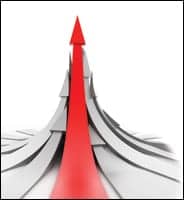 |
Shift-work sleep disorder (SWSD), in which off-hour workers find it difficult to sleep during daylight hours or return intermittently to normal evening sleep patterns, is one of several common circadian rhythm disorders being treated with light therapy. Although a 1990 study in the New England Journal of Medicine concluded that SWSD “can be treated effectively with scheduled exposure to bright light at night and darkness during the day,”1 years later, light therapy is perhaps still best known as a treatment for seasonal affective disorder (SAD).
As awareness of SAD and other circadian rhythm disruptions becomes more prevalent, light therapy manufacturers are developing new types of light box devices and light sources to address this growing market. Insurance companies, however, are only beginning to reimburse for light therapy when SAD is diagnosed.
Light Therapy Treatments
SAD can be treated in a number of ways. Some patients respond well to light therapy alone, while some find that medications such as selective serotonin reuptake inhibiters (SSRIs) are more effective. Others may utilize a combination of both therapies.
|
Compare light therapy products with Sleep Review’s online product guide.
|
Light therapy for other circadian rhythm disorders has also been widely studied. A recent paper published in Sleep concluded that “short-wavelength light is a powerful agent that immediately attenuates the negative effects of both homeostatic sleep pressure and the circadian drive for sleep on alertness, performance, and the ability to sustain attention.”2
SAD light therapy patients are normally directed to turn on the light box in the morning. Patients should be in proximity to the box, perhaps within 2 feet. The optimal distance of the light source will depend on the device’s lux.
Depending on the lighting device, the patient, and the disorder, treatments can last from as little as 15 minutes to 2 hours. Some manufacturers simply recommend applying therapy until one feels a change in mood, energy, and alertness, although many devices have timers that will automatically turn the device off after a certain time.
The time of day that one applies the light is integral to the therapy as well. In general, SAD patients apply the light in the morning. Late night shift workers would use the devices before work, and then avoid as much light as possible on the way home to bed.
The New Types of Lighting Elements
The actual type of light and the amount of lux, which is the unit of measurement for light intensity related to distance, can vary by the manufacturer and particular model. Most manufacturers produce devices from 2,500 to 10,000 lux, depending on the type of lighting element. Normal incandescent light emits about 300 to 500 lux and has not proven effective for reducing symptoms of SAD or significantly changing circadian rhythms. Initial light boxes were comprised of a large array of fluorescent bulbs.
Larry Pederson, founder of the Litebook Company, Medicine Hat, Alberta, recalls the early fluorescent light boxes. While effective, they were large and cumbersome, and also emitted extraneous wavelengths of light that were not essential to the therapy. Pederson says, “The analogy that someone used was that it was almost like hitting a pin with a sledge hammer; it was very indiscriminate. Today, we’re hitting the same pin with a little ball-peen hammer. So it’s just a more efficient light delivery system.” That being said, there are still many 10,000-lux fluorescent light therapy products on the market.
Litebook specializes in modern white light-emitting diode (LED) lighting elements. Some of its latest models, such as the Litebook Elite, have 5,000-lux LEDs with a Fresnel lens. Pederson says that these innovations deliver a more uniform light with less glare, while still including the peak wavelength of the blue part of the light spectrum.
It is the blue spectrum of light—at about 460 nm—that is believed to affect particular photoreceptors in the retina. These photoreceptors are responsible for stimulating the brain’s suprachiasmatic nucleus (SCN), the so-called “circadian pacemaker.” When blue light signals the SCN, it affects both the production of melatonin, a hormone that prepares the body for sleep, as well as serotonin, a neurotransmitter that signals the body to wake up, and can also affect mood. Consequently, the timely signaling of the SCN through blue light—or lack of it—is theorized to greatly influence one’s sleep
cycle.3-5
Some devices, such as goLITE from Apollo Light Systems Inc, American Fork, Utah, have focused their technology on producing the optimal amount of blue light while eliminating other wavelengths. Research director Dan Adams explains, “Most 10,000-lux light boxes produce a whole lot more blue light than our little blue goLITE produces. By being able to eliminate those competing wavelengths, we don’t overstimulate the photoreceptors, and so we’re able to get a much stronger, quicker response with lower levels of blue.”
Aside from offering different wavelengths of light and different lighting elements, manufacturers are updating their products to be smaller, less heavy, and more portable. The last few years have also seen the introduction of more dawn simulation products. Dawn simulators are timed to turn on while a patient is still asleep, then slowly increase the intensity of light, mimicking natural sunlight that normally enters a room in the spring or summer.
FDA Future Acceptance Getting Brighter?
As of yet, the FDA has not approved any light therapy device for SAD or any type of circadian rhythm disorder, still deeming light therapy as experimental. However, independent and manufacturer-sponsored research is ongoing, and light therapy makers say that they will hopefully be presenting their evidence to the FDA within the next several years.
Pederson says, “It’s a slowly improving situation. Some of the private insurance companies are starting [to cover light therapy]. I think the dynamic with insurability will change dramatically once FDA clearance is in place. We’re working on it, and our goal is to have that not only for SAD but for a variety of sleep disorders.”
Tor Valenza is a staff writer for Sleep Review. He can be reached at [email protected].
References
- Czeisler CA, Johnson MP, Duffy JF, Brown EN, Ronda JM, Kronauer RE. Exposure to bright light and darkness to treat physiologic maladaption to night work. N Engl J Med. 1990; 322:1253-1259.
- Lockley SW, Evans EE, Scheer FAJL, Brainard GC, Czeisler CA, Aeschbach D. Short wavelength sensitivity for the direct effects of light on alertness, vigilance, and the waking electrocardiogram in humans. Sleep. 2006;29:161-168.
- Brainard GC, Hanifin JP, Greeson JM, et al. Action spectrum for melatonin regulation in humans: evidence for a novel circadian photoreceptor. J Neurosci. 2001;21:6405-6412.
- Thapan K, Arendt J, Skene DJ. An action spectrum for melatonin suppression: evidence for a novel non-rod, non-cone photoreceptor system in humans. J Physiol. 2001;535(Pt 1):261-267.
- Rea MS, Bullough JD, Figueiro MG. Phototransduction for human melatonin suppression. J Pineal Res. 2002;32:209-213.



